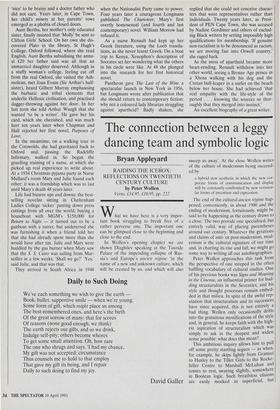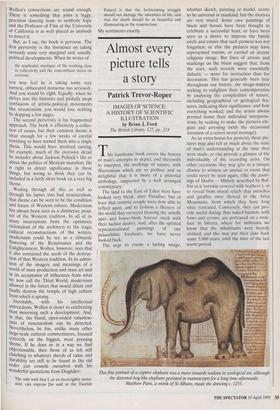The connection between a leggy dancing team and symbolic logic
Bryan Appleyard
RAIDING THE ICEBOX: REFLECTIONS ON TWENTIETH CENTURY CULTURE by Peter Wollen Verso, £34.95, £10.95, pp. 222 Vilrhat we have here is a very impor- tant book struggling to break free of a rather perverse one. The important one can be glimpsed close to the beginniag and close to the end.
In Wolien's opening chapter we are shown Diaghilev speaking at the Tauride Palace of the impending collapse of Rus- sia's and Europe's andel? regime 'in the name of a new and unknown culture, which will be created by us, and which will also
sweep us away'. At the close Wollen writes of the culture of modernism being succeed- ed by
a hybrid new aesthetic in which the new cor- porate forms of communication and display will be constantly confronted by new vernacu- lar forms of invention and expression.
The end of the cultural ander: regime hap- pened. conveniently, in about 1900 and the ending of modernism, fortuitously, might he said to be happening as the century draws to a close. The two provide one specialised, but entirely valid, way of placing parentheses around our century. Whatever the grations and claims of anti- or post-modernism, mod- ernism is the cultural signature of our time and, in charting its rise and fall, we might go some way to writing all our autobiographies.
Peter Wollen approaches this task from the perspective of one steeped in the often baffling vocabulary of cultural studies. One of his previous books was Signs and Meaning in the Cinema, an influential primer for bud- ding structuralists in the Seventies, and his style and thought processes remain embed- ded in that milieu. In spite of the awful rep- utation that structuralism and its successors have since acquired, this is not entirely a had thing. Wollen only occasionally drifts into the gratuitous mystifications of the style and, in general, he keeps faith with the high- est aspiration of structuralism which was simply to ask in the deepest and widest sense possible: what does this mean?
This ambitious inquiry allows him to pull off some pretty startling segues — as when: for example, he skips lightly from Gramsci to Huxley to the Tiller Girls to the Rocke- feller Centre to Marshall McLuhan and comes to rest, swaying slightly, somewhere in Boolean logic. Such breathless elisions are easily mocked as superficial, but
Wollen's connections are sound enough. There is something that joins a leggy, precision dancing team to symbolic logic and the Professor of Film at the University of California is as well placed as anybody to detect it.
But, as I say, the book is perverse. The first perversity is the insistence on taking seriously some very marginal and, usually, Political developments. When he writes of
the syndicalist mystique of the working class as collectivity and the concomitant stress on activism,
you may feel he is taking some very earnest, obfuscated nonsense too seriously. And you would be right. Equally, when he delves into the histories and pitifully inept confusions of artistic-political movements like situationism, you would lose nothing by skipping a few pages.
The second perversity is his fragmented approach. The book is effectively a collec- tion of essays, but their common theme is Clear enough for a few weeks of careful rewriting to have turned them into a single thesis. This would have involved cutting, for example, much of the excessive detail he includes about Jackson Pollock's life or about the politics of Mexican muralists. He is right to detect significance in these things, but wrong to think they can be included in a fairly short book on a very big theme.
Wading through all this as well as through his lapses into bad structuralism, that theme can be seen to be the condition and future of Western culture. Modernism has always been seen as a distinctive prod- uct of the Western tradition. In all of its many incarnations from the optimistic rationalism of the architects to the tragic cultural reconstructions of the writers, modernism could be see as a climactic flowering of the Renaissance and the Enlightenment. Wollen, however, sees that it also contained the seeds of the destruc- tion of that Western tradition. In its admis- sion of the imagery and meanings of a world of mass production and mass art and in its acceptance of influences from what we now call the Third World, modernism allowed in the forces that would dilute and finally destroy the temple of high culture from which it sprang. Inevitably, with his intellectual antecedents, Wollen is closer to celebrating than mourning such a development. And, in that, the bland, open-ended valueless- ness of structuralism can be detected. Nevertheless, he has, unlike many other large-scale cultural commentators, focused correctly on the biggest, most pressing theme. If he does so in a way we find Objectionable, then those of us left still clutching to whatever shreds of value and durability are still to be found in the old order can console ourselves with his wonderful quotations from Diaghilev:
The only wish that 1, as an incorrigible sensu- alist, can express [he said at the Tauride Palace] is that the forthcoming struggle should not damage the amenities of life, and that the death should be as beautiful and illuminating as the resurrection.
My sentiments exactly.



























































 Previous page
Previous page